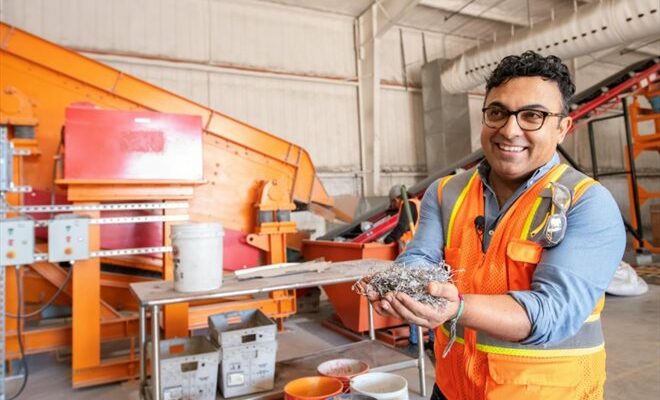Workers handle a solar panel ready to be recycled at a recycling plant in Yuma, in the US state of Arizona, December 6, 2023 (AFP/VALERIE MACON)
Photovoltaics, booming in the United States, should make it possible to gradually replace polluting energy sources. But out-of-use solar panels are often simply thrown away, with the recycling industry still in its infancy.
Under a hangar in Yuma, a small town in Arizona (southwest), workers control the machines which crush these large glass plates.
“We are seeing the first generation of solar panels being recycled,” says Adam Saghei, boss of We Recycle Solar, a company that has been seeking to give them a second life for years.
“And the great thing is that we are at the forefront” of this emerging industry, he told AFP, behind his machines in Yuma, near the border with Mexico.
Solar energy “is a renewable energy and we must find a solution for the retirement of these materials,” he insists in his fluorescent orange safety vest.
Because after a lifespan of around thirty years, solar panels end up, by default, in landfills, without being recycled, which leads to the loss, in the process, of minerals contained in the photovoltaic cells.

Materials from disused solar panels at a recycling plant in Yuma, in the US state of Arizona, December 6, 2023 (AFP/VALERIE MACON)
It is precisely to recover these precious elements, including silver and copper, that We Recycle Solar engineers have been working for three years.
Behind this research lies an essential issue for the solar sector: to show that its sector, which wants to replace that of polluting fossil fuels, does not itself cause damage to the environment.
The question is all the more important as the United States is investing massively in solar power to produce electricity in a cleaner way.
– “Tsunami of solar panels” –
“Very soon there will be a tsunami of solar panels that will come back” after their use, predicts Adam Saghei. In front of his hangar, piles of these large unusable plates are piled up.
A first part of these panels, the least damaged, are renovated in order to be resold at a lower price on other markets.
Those that cannot be repaired then become “mines” from which materials are extracted for resale.

Disused solar panels wait to be recycled near a recycling plant in Yuma, in the US state of Arizona, December 6, 2023 (AFP/VALERIE MACON)
This is the case for silver and copper. We Recycle Solar workers place these large panels in crushers, notably pulling out fine silver filaments.
At the Yuma site, the company says it can recycle up to 7,500 solar panels per day. And, in total, their technology makes it possible to recycle “up to 99%” of materials, depending on the type of panels,” says Adam Saghei.
But this process is expensive. Not only does the resale of recovered products not make it possible to finance recycling, but the collection of scattered panels, here on the roofs of individual houses, there in large installations in the plains, is complex.
And the United States passes these costs on to the end user, which pushes the latter to go to the landfill rather than to a recycling channel.
– “Support from public authorities” –

The boss of the We Recycle Solar company Adam Saghei at his recycling plant in Yuma, in the US state of Arizona, on December 6, 2023 (AFP/VALERIE MACON)
“We need support from the public authorities” to finance this stage of recycling, believes Meng Tao, specialist in renewable energies at Arizona State University.
For him, developing an efficient life cycle for solar panels is an urgent issue.
With the United States committed to limiting fossil fuels at the recent COP28, the installation of solar panels is expected to peak within two decades.
When the sector reaches “maturity”, the pace of panel installations and their dismantling once worn out “will be approximately the same”, observes Meng Tao.
“There are not many people getting into this sector, because recycling is expensive,” confirms business manager Adam Saghei. “It requires a lot of manpower, a lot of energy.”
For him, the solution is to resell the recovered materials to the solar industry to reuse them in the manufacture of new panels.
And, he hopes, “when the industry moves to larger volumes, we will be able to reintroduce these materials into the supply chain.”
© 2023 AFP
Did you like this article ? Share it with your friends using the buttons below.




